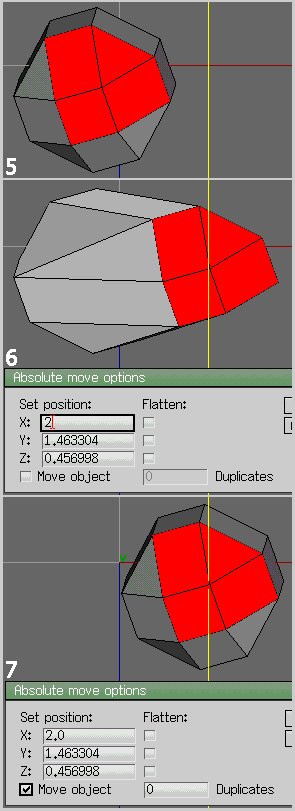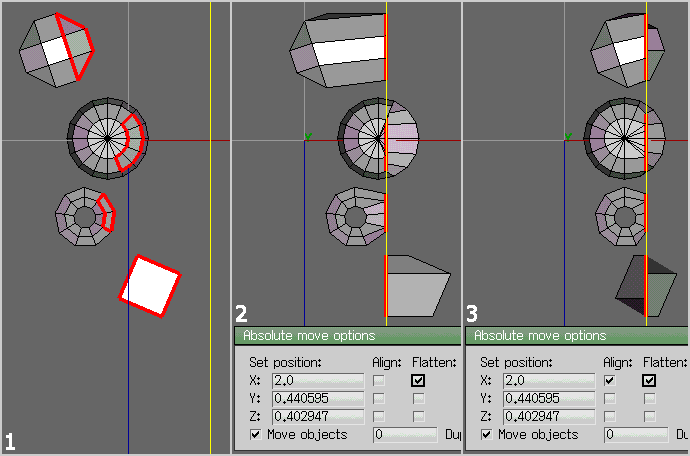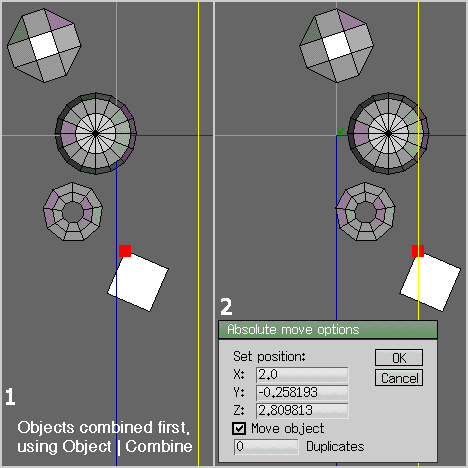| Move | Absolute main page |
 |
 |
 |
| Multiple object behaviour
- Flatten (without / with Align) Flatten :- In multi-object situations, Flatten works as usual, but depending on whether the align option is also used, then one of two different results will be obtained. Flatten without Align : MA considers all selected geometry to be a vert selection - irrespective of the type of elements that are actually selected. Geometry will then be flattened to the (single) appropriate plane that passes through the selection centre computed from all these selected (pseudo) verts. In this case, selected geometry (only) will move (to the single flatten plane) - but since the remainder of the objects won't move, they retain their positions with respect to each other. (1) Original position of objects and selected geometry. (2) If the Move Objects option is also used, all selected geometry will be flattened to a single plane based on the overall selection (as described above) - and then the objects moved so that this flatten plane lies at the specified co-ordinates. (3) Flatten with Align : MA essentially treats each object as a separate entity and uses each objects individual selection centre for the Flatten part of the operation, then moves each object so that the now-flattened geometry lies at the specified co-ordinates. Since there are considerable differences between the two results, it's something that's worth checking out - imo. |
| Move Absolute (MA)
This feature offers the user a means of moving selected elements (or whole objects) to specified absolute co-ordinates in 3D space – as opposed to the usual Move commands which only moves geometry in a relative manner. Various sub-options are also provided to extend the functionality of the command, but in typical wings style – will only be displayed when a valid situation allows. Although the essence of this command is straightforward – moving selected geometry to a specifed position – the behaviour of this command and the range of options available are influenced by the exact nature of the selections and number of objects involved. Because of the wide range of possibilities available, it’s suggested that users spend some time familiarising themselves in order to gain the maximum benefit from this xcellent new command. A general point of information that’s valid for all scenarios: The co-ordinates displayed in the MA dialog when first opened are those of the selection centre for ALL selected geometry, irrespective of the number of objects involved or the type / nature of the selected elements. This 'centre of selection' point plays a key role in the way MA operates. (Doing a Scale Uniform > 0% on the selected geometry (after changing to vert mode for edges, faces) will produce a point / origin with the same co-ordinates as those displayed.) No attempt will be made to cover / illustrate all possible options, but hopefully the examples depicted will give any prospective user a reasonable understanding of what's going on, so that they can further explore the possibilities themselves. All actions have been carried out along the X axis only (for ease of illustration) and I have set X = 2 in all relevant cases. The Y, Z co-ordinates seen in the MA dialog box are those relevant to the selection centre for the selected element(s) All views are along the Y axis (in Ortho) and the yellow line indicates the edge of the X = 2 plane as a visual aid to better show alignment etc. |
| Single object behaviour
(1, 5) Objects in their initial positions showing selected elements |
| Duplicates :-
(4) As the name suggests, using this option (with n = 1) will produce a single duplicate (and flattened, where applicable) version of the original and place it at the specified position. When more than one duplicate is requested (n > 1) then all subsequent duplicates are placed at positions based upon the initial displacement vector between the original object and the first duplicate. (I use the term vector, because the initial displacement will be a non-orthogonal move if new co-ordinates are entered in 2 (or 3) of the XYZ entry fields - as opposed to the single axis (X) moves as used in these examples.) As would be expected, the ‘Move Objects’ box has to be ticked to validate the Duplicates option. (If none of the original co-ordinates are changed (because you want your dupes at the same position) you still need to tick the Move Object box in order to activate the Dupes option.) Note that the original object doesn't move (and stays selected after using the duplicate option) so a Select | By > ID can still be used to 'find' the original object. |
| Move selected element(s) only: -
(2, 6) User enters desired co-ordinate, just X=2 here, OKs - and only those selected elements will be moved to the desired location . (these pics show the situation after executing the op.) Since unselected parts of the object don’t move, the shape of the object will be modified For any selection (involving multiple selected elements, as in (6)), the selection centre will be placed at the specified location after execution of the command. (Therefore, using a single vert will often provide the most precise and predictable option to the user.) Note that a 'Flatten' option is being displayed for the object with a face selection - as opposed to that with a single selected vert (where flatten doesn't make any sense... ) If > 1 vert is selected, then a Flatten option will also be displayed. |
| Move Object :-
(3, 7) This will move the whole object, so that the selection centre lies at the specified location. As the whole object is moved during this operation, it doesn’t change shape. |
| Flatten :-
If a selection other than a single vert is made (can’t flatten a vert) then the Flatten option is displayed and its use produces the same results as Face (or Vert) | Flatten. (8) Using MA Flatten without altering any co-ordinates will produce an identical result to a standard Flatten XYZ op. (along X here) – but since MA works with edge selections, the user also now has an Edge | Flatten command :). (The co-ordinates displayed upon invoking MA are those of the selection centre and therefore indicate the position through which the flatten plane will pass.) (9) Flatten + entering new co-ordinates will flatten the geometry to the appropriate plane which passes through the specified co-ordinates. Using this option is conceptually similar to using a Flatten RMB workflow, where the user again specifies a particular flatten plane - albeit by using geometry elements rather than entering co-ordinates, as with MA.. As elsewhere, flattening to 2 axes will produce a ‘line’ and 3 axes a single ‘point’- a fact that I could see having particular use in certain modelling scenarios (esp. the 2 axis / 'line' one) (10) If the Move Object option is also used, then the selected geometry will be flattened - with the flatten plane passing through its selection centre and then moved so that the (now flattened) selected elements lie at the specified co-ordinates. (11) With Duplicate also used, further identical flattened objects will be positioned according to the initial displacement between the original object and the first (flattened) duplicate object. |
 |
| Move selected elements only :-
(2) If selections exist on more than one object then those selections only will be moved such that the overall selection centre for ALL selected elements will lie at the specified co-ordinates. (3) If Align is also used, then all individual selection centres will be moved to the specified co-ordinates. |
| Move Object(s) :-
(4) All objects will be moved such that the overall selection centre for all the selected elements lies at the specified location. Since the objects will be moved as a single entity, their 3D inter-relationship will not be affected – ie their positions, relative to each other – will NOT change. (5) With Align, all objects will be moved (possibly by different amounts) so that each object's selection centre is moved to the specified co-ordinates. It is therefore possible that the positions of the objects - with respect to each other - will therefore be altered. NB If all objects are selected and combined (Object | Combine) then other possibilities present themselves to the user. (See below) |
| Duplicate:-
(6) Duplicates of the original objects are created and moved so that the overall selection centre (of the duplicate objects) lies at the specified co-ordinates. If more than one duplicate set is created, then subsequent sets will be displaced from their preceding neighbour by the same amount as the distance between the original objects and the first set of duplicates. (7) Using align with a single set of duplicates produces the result shown here. It should be apparent that the Duplicate and Align options cannot both be used at the same time (when N > 1) because the first duplicates will each have been moved different distances (with respect to the original objects) to the alignment position. To then create further sets of duplicate objects, aligned in a similar manner to the first set, requires a pitch spacing dimension to be input - for which there is no provision. To achieve this result, the user would create a single set of aligned duplicates - and then use these objects to create further aligned sets - ie a 2 stage operation. . If the user attempts to do the above (multiple aligned dupes) MA wil treat these inputs as invalid - and create the correct number of duplicates - but they won't be aligned. NB -Remember that you'll be dealing with non-orthogonal displacements if 2 (or more) xyz fields are changed. |
| Multiple object behaviour |
| (1) Initial positions of the objects - with a single vert selected on each object. |
 |
 |
| Combining objects before using Move Absolute (1) If all objects are selected and combined (Object | Combine) then other possibilities present themselves to the user. (Original configuration shown here) (2) In this situation, user will only have to make a single selection (even a single vert) on any object - and the whole group of objects will be moved - as one entity, so that the single vert (in this example) ends up at the specified co-ordinates. Using combine in this way therefore offers a way of precisely moving a group of objects around - without altering their positions with respect to each other. |